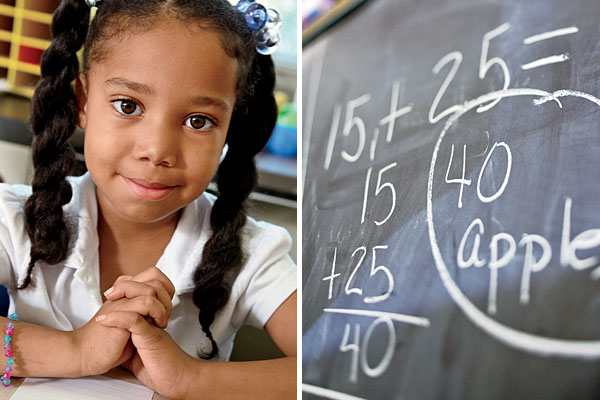Additional research by Geoffrey Johnson, Kaitlin Petersen, and Margaret Rhodes

Leland Elementary School in Chicago’s Austin neighborhood
Rankings:
Chicago »
Cook County »
DuPage County »
Kane County »
Lake County »
McHenry County »
Will County »
Related:
Getting In »
An admissions guide for the city's most prestigious public schools
Six Great Schools »
A look inside some schools that performed well on our charts
Illinois's Budget Crisis Leaves Schools Scrambling »
Educators are working to cut costs—without cutting classroom programs
Methodology »
How we ranked the schools. PLUS: A guide to the columns in the charts
At Chicago’s Leland Elementary School, every kindergarten, first-grade, and second-grade student gets sent to the principal at least four times a year.
But children aren’t sent there because they misbehaved. Instead, the school’s principal, Loretta Brown-Lawrence, meets with each of those students to check his or her mastery of a set list of reading words. She also visits each classroom several times a year to quiz students in math.
Situated in the city’s Austin neighborhood, Leland has about 200 students in pre-kindergarten through third grade—and 93 percent of them come from low-income families. Yet in the 2008–09 school year, 84 percent of Leland’s third-grade students met or exceeded state standards on the Illinois Standards Achievement Test (ISAT)—surpassing not only the 67.5 percent average for the city’s public schools but also the statewide meets-exceeds average of 79.8 percent. Combined with relatively low class sizes, those test scores earned Leland a spot on Chicago’s list of the city’s high-achieving public schools, part of our extensive look at the metro area’s public elementary schools. (Leland’s numbers, like all the statistics in the school charts, come from the 2008–09 school year, the most recent data available at presstime.)
At a time when the state’s public schools are confronting a worsening financial crisis (see “Illinois's Budget Crisis Leaves Schools Scrambling”), figuring out how certain schools succeed at educating their students has become crucially important. At Leland, as at other good schools, the drive to succeed comes from the top down. “[Children] only get one shot at getting started the right way,” says Brown-Lawrence, a former high-school math teacher. Her personal involvement with her pupils “lets everyone know how important we think reading and math are for their [future] learning. The parents know it, the teachers know it, and our students know it.”
Success can follow different pathways, so a principal’s approach can change from school to school. Roberta Wallerstedt, the principal at Park View Elementary School in Lombard, sometimes goes for a run with her students to underscore the school’s tripartite emphasis on academic, emotional, and physical well-being. “Kids don’t score well on tests if they’re unhappy, if they don’t have friends, if they’re physically not feeling well and fit,” Wallerstedt says. “All those are part of being able to think and learn.”
That approach seems to be paying off. At Park View, 95.7 percent of the students met or exceeded state standards—and the school managed that while spending markedly less than its more affluent counterparts in Oak Brook, Burr Ridge, and Hinsdale. On our charts, that earned Park View a high grade for efficiency, a category we have created to evaluate the relationship between a school’s academic performance and the money it spends. The less a school spends and the higher its test scores, the better its efficiency grade. Certainly high test scores do not rely on finances alone, but in these days of shrinking budgets, a school that manages to leverage its spending stands out.
In the charts (coming soon), we list the top schools in Chicago and in Cook, DuPage, Kane, Lake, McHenry, and Will counties. The data come from the 2008–09 report cards issued by the Illinois State Board of Education.Using that data, Chicago assigned each school a ranking (based, in most cases, on test scores, pupil-teacher ratio, and spending per student) and an efficiency grade. Rankings and efficiency grades don’t necessarily align; as you will see, some high-ranking schools received low efficiency grades.
Ultimately these charts are about results. Not coincidentally, the teachers and other school personnel whose daily work is measured by these charts are also focused intently on results. Whether grilling kids on their sight-reading words or demonstrating the role endorphins play in improving mental focus, educators these days are zeroing in on whatever methods and tools they can find to enhance learning. “We’re going to make sure the kids who come to us find success somehow, some way,” says Kelley Gallt, the principal of Lincoln Elementary School in Plainfield, another standout school.
Doing that gets harder all the time, with school budgets shrinking rapidly and out-of-school distractions growing—the kinds of things that can significantly impact student performance. At Leland, for example, those admirable test scores from 2009 took a hit in a more recent round of testing. While Chicago and other media won’t get the 2010 report cards until October, school administrators have already seen the results. According to Brown-Lawrence, Leland’s test scores will be lower, with only 67 percent of 2009–10 third graders meeting or exceeding state standards (first- and second-grade students don’t take the standardized tests). “We don’t know why [the scores for this class dropped],” she says. “We don’t know what changed. But the teachers and I know we have to work even harder.”
photography: Katrina Wittkamp


